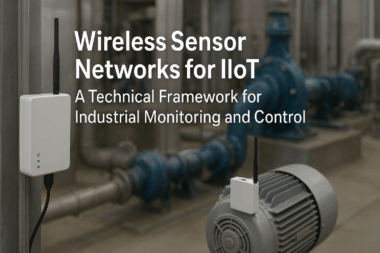Introduction
Integrating Cloud Computing with the Industrial Internet of Things (IIoT) has revolutionized the industrial landscape, brought unprecedented advancements, and transformed organizations’ operations. The convergence of Cloud Computing and IIoT enables real-time data collection, analysis, and control, empowering businesses with enhanced operational efficiency, cost savings, and data-driven decision-making. From scalability and flexibility to real-time analytics and remote monitoring capabilities, the advantages of integrating Cloud Computing with IIoT are immense. By understanding the potential of Cloud Computing in IIoT and overcoming the associated challenges, organizations can unlock new opportunities for innovation, efficiency, and competitiveness.
The Convergence of Cloud Computing and IIoT
The convergence of Cloud Computing and the Industrial Internet of Things (IIoT) has brought a transformative synergy in the industrial landscape.
Cloud Computing provides scalable infrastructure, storage capabilities, and advanced analytics tools, complementing the real-time data collection, analysis, and control facilitated by IIoT. The combination enables enhanced operational efficiency, cost savings, real-time analytics, and remote monitoring capabilities.
By integrating Cloud Computing with IIoT, organizations can achieve streamlined operations, improved productivity, proactive maintenance, optimized resource utilization, and reduced downtime. The scalability and flexibility of cloud solutions enable businesses to accommodate the exponential growth of IIoT devices and data. Real-time analytics and insights from IIoT data drive informed decision-making and process optimization. Additionally, remote monitoring and control capabilities empower organizations to monitor operations from anywhere, improving efficiency and reducing maintenance costs.
However, security, interoperability, and data governance challenges must be addressed to ensure successful implementation. By navigating these challenges, organizations can unlock the full potential of Cloud Computing in IIoT, revolutionizing industrial operations and driving innovation across various sectors.
Cloud Computing in Predictive Maintenance
Cloud Computing has revolutionized predictive maintenance, offered advanced capabilities, and transformed maintenance practices. Organizations can effectively gather, store, and analyze enormous amounts of data created by sensors and devices in real-time by utilizing the power of the cloud. This enables the deployment of advanced analytics and machine learning models to predict equipment failures and proactively schedule maintenance, reducing costly unplanned downtime.
Cloud-based predictive maintenance systems provide actionable insights and early warning signals, improving equipment reliability, reducing maintenance costs, and optimizing asset utilization. The cloud facilitates collaboration and knowledge sharing among maintenance teams, enabling efficient decision-making. However, data security, privacy, and interoperability considerations must be addressed for successful implementation. Cloud Computing empowers organizations to transition from reactive to proactive maintenance strategies, ensuring higher equipment availability and maximizing operational efficiency.
Step-by-Step Process of Cloud Computing in Predictive Maintenance:
- Data Collection: Sensors and devices installed on industrial equipment collect real-time data on temperature, vibration, pressure, and performance metrics.
- Data Transmission: The collected data is securely transmitted to the cloud infrastructure using protocols like MQTT or CoAP, ensuring reliable and efficient data transfer.
- Cloud Storage: The stored data provides scalable and secure storage capabilities. Cloud storage ensures that the data is readily accessible for analysis and processing.
- Data Preprocessing: Before analysis, the collected data may undergo preprocessing steps such as cleansing, normalization, and feature engineering to ensure data quality and relevance.
- Analytics and Machine Learning: Advanced analytics tools and machine learning algorithms are applied to the stored data in the cloud. These techniques analyze the data, identify patterns, detect anomalies, and train predictive models.
- Predictive Model Development: Machine learning models are developed using historical data and patterns to predict potential equipment failures. These models can identify early warning signs and provide insights into maintenance requirements.
- Real-Time Analytics: Cloud-based analytics tools continuously monitor incoming data streams in real-time. They apply predictive models to detect anomalies and trigger alerts when maintenance interventions are needed.
- Alert Generation: Based on the analysis results, alerts and notifications are generated, informing maintenance teams about potential failures or maintenance requirements. These alerts can be delivered through email or SMS or integrated with existing enterprise systems.
- Remote Monitoring and Control: Cloud-based predictive maintenance systems enable remote access to real-time data and analytics. Maintenance teams can monitor equipment performance, track health indicators, and remotely control equipment.
- Maintenance Planning and Execution: Maintenance teams utilize the insights and alerts generated by the cloud-based system to plan and execute maintenance activities proactively. Predictive maintenance schedules are optimized to minimize downtime and maximize equipment availability.
- Continuous Improvement: The cloud collects and analyzes feedback data from maintenance activities. This feedback loop helps refine the predictive models, improving their accuracy and effectiveness.
By following this step-by-step process, organizations can leverage the power of Cloud Computing to implement predictive maintenance strategies, enhance equipment reliability, reduce maintenance costs, and optimize overall operational efficiency.
Components and Software Used for Cloud Computing in Predictive Maintenance:
- Industrial IoT Sensors and Devices: These physical components are installed on industrial equipment to collect real-time data on temperature, vibration, pressure, and performance metrics.
- Cloud Infrastructure: Cloud service providers offer the necessary computing infrastructure, including servers, storage, and networking, to host and process the collected data.
- Cloud Storage: Cloud-based solutions provide scalable and reliable storage capabilities to store incoming sensor data securely. Examples of cloud storage services include Amazon S3, Google Cloud Storage, and Microsoft Azure Blob Storage.
- Cloud Analytics and Machine Learning Platforms: Cloud platforms offer advanced analytics tools and machine learning frameworks for processing and analyzing the collected data. Popular venues include Amazon Web Services (AWS) Machine Learning, Google Cloud ML Engine, and Microsoft Azure Machine Learning.
- Data Preprocessing Tools: Data preprocessing software is used to clean, normalize, and transform the raw sensor data before it is fed into the predictive models. Tools like Python libraries (e.g., Pandas, NumPy) and data integration platforms (e.g., Apache NiFi) are commonly used.
- Predictive Analytics and Machine Learning Algorithms: Various algorithms, such as regression, decision trees, random forests, and neural networks, are employed to develop predictive models. These models utilize historical data to forecast potential equipment failures and maintenance requirements.
- Real-Time Analytics and Visualization Tools: Real-time analytics platforms and visualization tools enable the monitoring and analyzing incoming data streams. These tools provide dashboards, alerts, and visual representations of data patterns and anomalies. Examples include Tableau, Power BI, and Grafana.
- Collaboration and Communication Tools: Cloud-based collaboration tools facilitate communication and knowledge sharing among maintenance teams. These tools enable seamless collaboration, documentation, insights, and analysis results sharing. Examples include project management platforms (e.g., Asana, Trello) and communication tools (e.g., Slack, Microsoft Teams).
- Integration and APIs: Integration tools and APIs connect and exchange data between different systems and platforms. These enable seamless sensor data integration, analytics, and maintenance management systems, ensuring efficient data flow and interoperability.
By leveraging these components and software, organizations can effectively implement Cloud Computing in predictive maintenance, enabling proactive maintenance strategies, data-driven decision-making, and optimized asset management.
Overcoming Challenges and Ensuring Success
Security and Privacy: Organizations must implement robust security measures, including encryption, access controls, and threat monitoring, to safeguard IIoT data and systems. Compliance with data privacy regulations and industry standards is crucial.
Interoperability and Standardization: Ensuring interoperability between IIoT devices, protocols, and cloud platforms is essential for seamless data exchange. Embracing open standards and protocols facilitates integration and avoids vendor lock-in.
Bandwidth and Latency: IIoT applications generate vast amounts of data that must be transmitted to the cloud in real-time. Optimizing data transmission protocols and adopting edge computing techniques can mitigate bandwidth limitations and reduce latency.
Data Governance and Ethics: Establishing clear data ownership, consent, and retention policies is vital to adhere to ethical and legal requirements. Organizations should implement data governance frameworks and consider the ethical implications of data collection and usage.
Conclusion
The convergence of Cloud Computing and IIoT is revolutionizing industrial operations across sectors. Organizations can achieve enhanced operational efficiency, cost savings, and data-driven decision-making by leveraging the cloud’s scalability, flexibility, real-time analytics, and remote monitoring capabilities. To ensure the successful adoption of cloud computing in IIoT, it is essential to address security, interoperability, and data governance issues. Organizations may maximize the potential of these technologies and promote innovation in the industrial environment with careful planning and a strategic approach.



